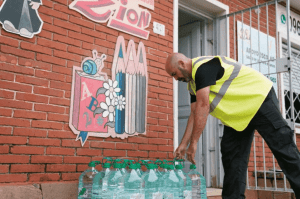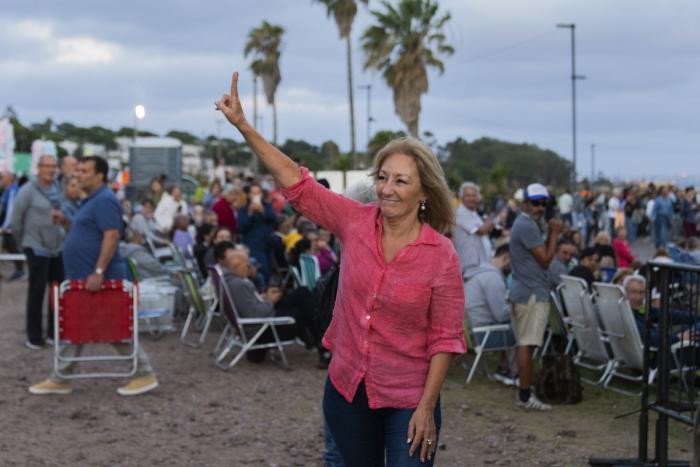 Read More
Read More
When Montevideo ran out of water, data provided a lifeline
The city’s focus on building cross-cutting data capacity made a critical difference when the crisis hit.

Montevideo officials worked to systematically provide bottled water to those who needed it during last year's crisis. Photo by Agustin Fernandez courtesy city of Montevideo
Listen to This Article
Uruguay was three years into a drought last spring when people in Montevideo started to notice a strange taste in their drinking water. That’s because the Paso Severino reservoir, which is the city’s primary source of fresh water, was nearly empty, and the state-owned water utility began diverting brackish water from the Río de la Plata to replenish the supply. While the resulting sodium levels were deemed safe for most people—pregnant women and those with health conditions were warned against drinking from the tap—it was believed that the capital city was down to only a few days’ supply of fresh water.
So the city snapped into action—making water available to those who needed it and helping bring the crisis under control—with a response powered by the data committee that Mayor Carolina Cosse formed as part of her work with Bloomberg Philanthropies’ City Data Alliance. Indeed, data was the thread tying together the city’s many efforts, which included everything from sharing real-time water-quality updates with residents and identifying safe well-water reserves to microtargeting water-bottle delivery to people with medical conditions.
Montevideo’s data-driven response was so formidable and multifaceted that it may have helped encourage the national government to act, demonstrating how local data capacity can make a critical—and, in this case, life-or-death—difference.
Driving clear communication.
As local journalist Guillermo Garat wrote in The New York Times at the height of the crisis, “Here in Uruguay, clean water is part of our national identity.”
Garat’s account helps put in perspective the challenge facing city leaders. This wasn’t a run-of-the-mill utility or service problem—it was a systematic loss of confidence in a city that prided itself on being ahead of the curve when it came to natural resources. And there were signs of real suffering, including belly pain, diarrhea, and fear.
Mayor Cosse and her team knew the city and its data committee were going to be part of the solution from the outset. “When the water crisis became evident, and the only information from the national government was that the tap water would have salinity levels above what the regulations establish, [Montevideo] provided certainty in those moments of uncertainty and distress for the people,” Cosse explains.
Central to its multi-layered response was getting residents the information they needed. That involved first testing the water—both from the tap and from bottles—and then constantly sharing updated stats on sodium and chloride content through digital and print platforms.
“Everything was published daily—all the analyses that were done so that the population could make decisions about what type of water [bottle or tap] to consume,” adds María Eugenia Márquez Drews, a member of the data committee who was involved in the response.
Mainstreaming data practices to rally an entire city.
The integration of data use throughout departments and agencies was on full display in Montevideo, as data collection, analysis, and deployment were at the core of nearly every aspect of the city’s response.
It wasn’t enough to just test the water. The city also needed to determine who was most at risk and then ensure they had access to bottles. It used existing government data on vulnerable residents to do so, even grouping residents by pre-conditions and other reasons they needed special help. Drums of water were delivered to distribution sites for those in need, like residents with hypertension, and, when necessary—survivors of domestic violence or people with disabilities—water was delivered directly to doorsteps.
The city also tracked who actually received fresh water. That way, “we were able to make sure that the population we wanted to target was actually benefiting from the [initiative],” says Damián Pintos, the city’s chief data officer. And to shore up its own water infrastructure to ensure it wasn’t wasting precious resources, officials launched an effort inviting citizens to report leaks via WhatsApp. Working alongside the national government—which runs the water utility—local leaders mapped everything on a portal where residents could track progress in real time.
This mainstreaming of data extended even to individual businesses and residents, who were encouraged to share their own city-tested well water with neighbors.
This was solidarity in action. As one resident said at the time, “You can see that people want to help.”
Coordinating with partners at other levels of government.
Partnering with the national government is often essential for cities facing crisis, and this was especially so in Montevideo, given it’s a national agency—Obras Sanitarias del Estado (OSE)—that provides drinking water. From fixing leaky infrastructure to providing safe drinking water to ensuring the city’s original tap water supply was once again safe, the partnership has been a productive one. As Germán Iglesias, a data-committee member from the city planning department explains, “There was no other way than to work together.”
But that doesn’t mean the city waited for federal action. In fact, the national government didn’t declare an emergency until after city data began to reveal the scale of the crisis, according to local officials. By this point, the city was already distributing drums of bottled water to residents in need—and looking for ways to sharpen their response.
Keeping an eye on “what’s next.”
This work has left a lasting impression in city hall in large part because it demonstrated the potential of data-infused collaboration, with agencies as disparate as social policy and finance working together to get water where it needed to go. “Montevideo’s leadership embraced the process of developing and implementing a comprehensive citywide data strategy, and that effort contributed to the city’s ability to respond to this crisis so effectively,” says Amy Edwards Holmes, executive director of the Bloomberg Center for Government Excellence (GovEx) at Johns Hopkins University.
Now, the city is responding to residents’ desire for even more data by working to publish additional health stats, on food safety and ingredients like sugar, for example, to inform consumers’ decisions and confidence.
It’s all part of a culture of data-driven transparency in the city—one that has been fortified for the future, offering the city and its leaders assurance in deploying cross-cutting data work whenever conditions might demand.


